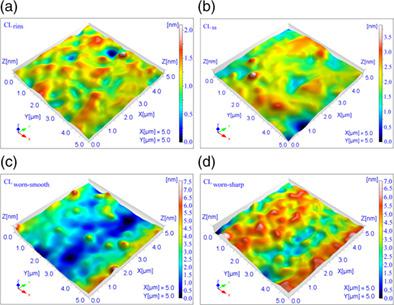当前位置:
X-MOL 学术
›
Microsc. Res. Tech.
›
论文详情
Our official English website, www.x-mol.net, welcomes your
feedback! (Note: you will need to create a separate account there.)
Advanced morphological analysis of siloxane-hydrogel contact lenses
Microscopy Research and Technique ( IF 2.0 ) Pub Date : 2021-05-25 , DOI: 10.1002/jemt.23833 Ştefan Ţălu 1
Microscopy Research and Technique ( IF 2.0 ) Pub Date : 2021-05-25 , DOI: 10.1002/jemt.23833 Ştefan Ţălu 1
Affiliation

|
The purpose of this work is to provide a better understanding of three-dimensional (3-D) surface texture of siloxane-hydrogel contact lenses (CLs) using atomic force microscopy (AFM) and stereometric analysis. The 3-D surface texture characterization of unworn/worn siloxane-hydrogel CLs made of Filcon V (I FDA group) was performed with stereometric analysis. The atomic force microscopy (AFM) measurements of surface roughness and micromorphology of CLs were made using a Nanoscope V MultiMode (Bruker) in intermittent-contact mode, in air, on square areas of 5 × 5 μm. Stereometric study of 3-D surface texture was made according with ISO 25178-2:2012 for CLrins (taken from the blister and rinsed with deionized water); CLss (preserved for 12 hr in saline solution and rinsed with deionized water); CLworn-smooth (worn for 8 hr and presenting the smooth type morphology), and CLworn-sharp (worn for 8 hr and presenting the sharp-type morphology). The 3-D surface texture of siloxane-hydrogel CLs was found to have specific morphological characteristics. Statistical parameters revealed local geometrical and morphological spatial structures at nanometer scale attributed to the specific interactions at the CLs surface. Before wear, the surface micromorphology of Filcon V CLs is regular with uniformly distributed microasperities and relatively small heights (Sq = 0.6 nm). After 12 hr in saline, it is found that the micromorphology changes relatively easily, but retaining the main morphological characteristics (Sq = 1.2 nm). After 8 hr of wear, there are two typical micromorphologies: smooth type, characterized by gutter structures and isolated microasperities (Sq = 2.5 nm), while the sharp type has an appearance with compactly arranged microasperities of hill type flanked by compactly arranged microregions of valley type (Sq = 2.2 nm). Surface statistical parameters allow manufacturers in developing the next generation of CLs with improved surface texture while improving biocompatibility and minimizing the impact of the material on corneal physiology. Furthermore, the micro-elastohydrodynamic lubrication due to surface texture at a nanometer scale between the back surface of the CL with the corneal surface and the front surface of the CL with the under-surface of the eyelid can be deeper and more nuanced to understand in light of modern tribological theories.
中文翻译:

硅氧烷水凝胶隐形眼镜的高级形态分析
这项工作的目的是使用原子力显微镜 (AFM) 和立体测量分析更好地了解硅氧烷-水凝胶隐形眼镜 (CL) 的三维 (3-D) 表面纹理。由 Filcon V(I FDA 组)制成的未磨损/磨损的硅氧烷-水凝胶 CL 的 3-D 表面纹理表征通过立体测量分析进行。CLs 的表面粗糙度和微形态的原子力显微镜 (AFM) 测量是使用 Nanoscope V MultiMode (Bruker) 以间歇接触模式、在空气中、在 5 × 5 μm 的方形区域上进行的。根据 ISO 25178-2:2012 对 CL冲洗(从泡罩中取出并用去离子水冲洗)进行 3-D 表面纹理的立体测量研究;CL SS(在盐水溶液中保存 12 小时并用去离子水冲洗);CL磨损光滑(磨损 8 小时并呈现光滑型形态)和 CL磨损锐利(佩戴 8 小时并呈现锐利型形态)。发现硅氧烷-水凝胶 CL 的 3-D 表面纹理具有特定的形态特征。统计参数揭示了纳米尺度的局部几何和形态空间结构,这归因于 CLs 表面的特定相互作用。磨损前,Filcon V CLs 的表面微形态是规则的,具有均匀分布的微细纹和相对较小的高度(Sq = 0.6 nm)。在盐水中12小时后,发现微形态变化相对容易,但保留了主要的形态特征(Sq = 1.2 nm)。磨损 8 小时后,有两种典型的微观形态:光滑型,以沟槽结构和孤立的微凹凸为特征(Sq = 2.5 nm),而尖锐型的外观具有紧密排列的山型微凹凸不平,两侧是紧密排列的谷型微区(Sq = 2.2 nm)。表面统计参数允许制造商开发具有改进表面纹理的下一代 CL,同时提高生物相容性并最大限度地减少材料对角膜生理的影响。此外,由于 CL 后表面与角膜表面和 CL 前表面与眼睑下表面之间的纳米级表面纹理导致的微弹性流体动力润滑可以更深入、更细微地理解现代摩擦学理论。表面统计参数允许制造商开发具有改进表面纹理的下一代 CL,同时提高生物相容性并最大限度地减少材料对角膜生理的影响。此外,由于 CL 后表面与角膜表面和 CL 前表面与眼睑下表面之间的纳米级表面纹理导致的微弹性流体动力润滑可以更深入、更细微地理解现代摩擦学理论。表面统计参数允许制造商开发具有改进表面纹理的下一代 CL,同时提高生物相容性并最大限度地减少材料对角膜生理的影响。此外,由于 CL 后表面与角膜表面和 CL 前表面与眼睑下表面之间的纳米级表面纹理导致的微弹性流体动力润滑可以更深入、更细微地理解现代摩擦学理论。
更新日期:2021-05-25
中文翻译:

硅氧烷水凝胶隐形眼镜的高级形态分析
这项工作的目的是使用原子力显微镜 (AFM) 和立体测量分析更好地了解硅氧烷-水凝胶隐形眼镜 (CL) 的三维 (3-D) 表面纹理。由 Filcon V(I FDA 组)制成的未磨损/磨损的硅氧烷-水凝胶 CL 的 3-D 表面纹理表征通过立体测量分析进行。CLs 的表面粗糙度和微形态的原子力显微镜 (AFM) 测量是使用 Nanoscope V MultiMode (Bruker) 以间歇接触模式、在空气中、在 5 × 5 μm 的方形区域上进行的。根据 ISO 25178-2:2012 对 CL冲洗(从泡罩中取出并用去离子水冲洗)进行 3-D 表面纹理的立体测量研究;CL SS(在盐水溶液中保存 12 小时并用去离子水冲洗);CL磨损光滑(磨损 8 小时并呈现光滑型形态)和 CL磨损锐利(佩戴 8 小时并呈现锐利型形态)。发现硅氧烷-水凝胶 CL 的 3-D 表面纹理具有特定的形态特征。统计参数揭示了纳米尺度的局部几何和形态空间结构,这归因于 CLs 表面的特定相互作用。磨损前,Filcon V CLs 的表面微形态是规则的,具有均匀分布的微细纹和相对较小的高度(Sq = 0.6 nm)。在盐水中12小时后,发现微形态变化相对容易,但保留了主要的形态特征(Sq = 1.2 nm)。磨损 8 小时后,有两种典型的微观形态:光滑型,以沟槽结构和孤立的微凹凸为特征(Sq = 2.5 nm),而尖锐型的外观具有紧密排列的山型微凹凸不平,两侧是紧密排列的谷型微区(Sq = 2.2 nm)。表面统计参数允许制造商开发具有改进表面纹理的下一代 CL,同时提高生物相容性并最大限度地减少材料对角膜生理的影响。此外,由于 CL 后表面与角膜表面和 CL 前表面与眼睑下表面之间的纳米级表面纹理导致的微弹性流体动力润滑可以更深入、更细微地理解现代摩擦学理论。表面统计参数允许制造商开发具有改进表面纹理的下一代 CL,同时提高生物相容性并最大限度地减少材料对角膜生理的影响。此外,由于 CL 后表面与角膜表面和 CL 前表面与眼睑下表面之间的纳米级表面纹理导致的微弹性流体动力润滑可以更深入、更细微地理解现代摩擦学理论。表面统计参数允许制造商开发具有改进表面纹理的下一代 CL,同时提高生物相容性并最大限度地减少材料对角膜生理的影响。此外,由于 CL 后表面与角膜表面和 CL 前表面与眼睑下表面之间的纳米级表面纹理导致的微弹性流体动力润滑可以更深入、更细微地理解现代摩擦学理论。











































 京公网安备 11010802027423号
京公网安备 11010802027423号